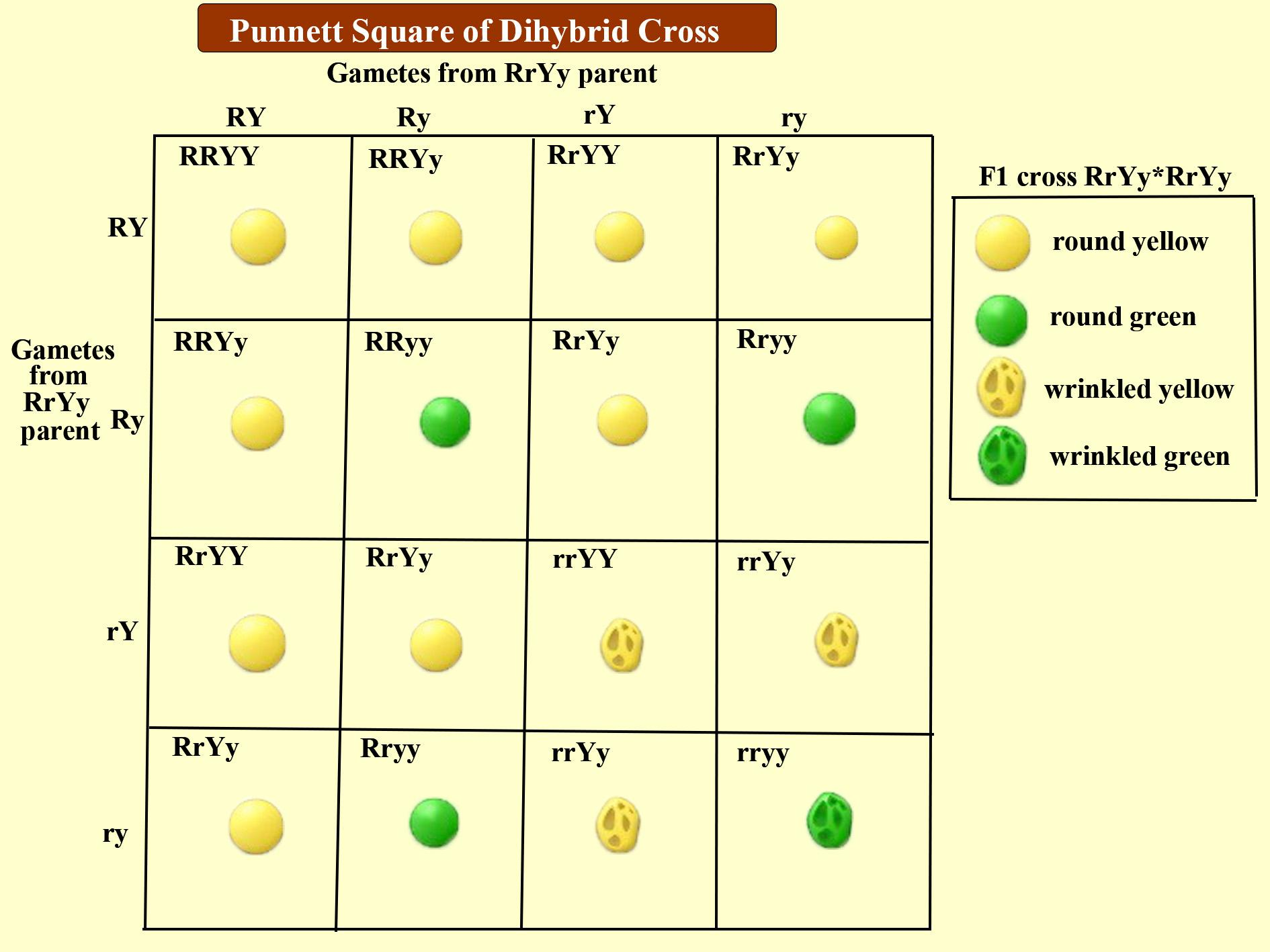
The phenotypic ratio in the dihybrid cross is
(a)
(b)
(c)
(d)
Answer
494.7k+ views
1 likes
Hint: The phenotypes obtained were out of the sixteen possible allele combinations obtained by crossing the male and the female gametes where two traits are taken into consideration.
Complete answer:
A dihybrid cross is a cross between two different genes of two different traits. Three are two types of traits, one is the dominant trait and the other is the recessive trait. The phenotypic ratio obtained in the dihybrid cross is
The dihybrid cross involves the two traits (e.g. R and Y) having two different alleles (e.g. R and r, or Y and y) to combine together for crossing their genetic information. The parents after gametes formation will form four gametes each (e.g. RY, Ry, rY, and ry). This cross is shown using the Punnett square.
The total offspring produced were sixteen having their different allele combinations. These combinations result in the production of nine offspring having both the dominant phenotypes, the six offsprings produced were having one dominant phenotype and one recessive phenotype, while the last one offspring produced consists of both the recessive phenotypes. The complete dominant and recessive phenotype display homozygous condition while those combinations which have both the dominant and the recessive alleles display heterozygous condition.
The rule of meiosis applied in the dihybrid cross is explained in Mendel's first and second laws, which are called the Law of Segregation and the Law of Independent Assortment.
So, the correct answer is ‘
Note: The Law of Segregation applies when the two individuals are in heterozygous condition. The offspring is different in genotype and phenotype both from their parents which depict the characters of the grandparents. The Law of independent assortment states that alleles of different traits are inherited independently from the other. The gamete produced due to independent assortment will have a mixture of the chromosomes of both the organisms.

Complete answer:
A dihybrid cross is a cross between two different genes of two different traits. Three are two types of traits, one is the dominant trait and the other is the recessive trait. The phenotypic ratio obtained in the dihybrid cross is
The dihybrid cross involves the two traits (e.g. R and Y) having two different alleles (e.g. R and r, or Y and y) to combine together for crossing their genetic information. The parents after gametes formation will form four gametes each (e.g. RY, Ry, rY, and ry). This cross is shown using the Punnett square.
The total offspring produced were sixteen having their different allele combinations. These combinations result in the production of nine offspring having both the dominant phenotypes, the six offsprings produced were having one dominant phenotype and one recessive phenotype, while the last one offspring produced consists of both the recessive phenotypes. The complete dominant and recessive phenotype display homozygous condition while those combinations which have both the dominant and the recessive alleles display heterozygous condition.
The rule of meiosis applied in the dihybrid cross is explained in Mendel's first and second laws, which are called the Law of Segregation and the Law of Independent Assortment.
So, the correct answer is ‘
Note: The Law of Segregation applies when the two individuals are in heterozygous condition. The offspring is different in genotype and phenotype both from their parents which depict the characters of the grandparents. The Law of independent assortment states that alleles of different traits are inherited independently from the other. The gamete produced due to independent assortment will have a mixture of the chromosomes of both the organisms.

Latest Vedantu courses for you
Grade 11 Science PCM | CBSE | SCHOOL | English
CBSE (2025-26)
School Full course for CBSE students
₹41,848 per year
Recently Updated Pages
Express the following as a fraction and simplify a class 7 maths CBSE

The length and width of a rectangle are in ratio of class 7 maths CBSE

The ratio of the income to the expenditure of a family class 7 maths CBSE

How do you write 025 million in scientific notatio class 7 maths CBSE

How do you convert 295 meters per second to kilometers class 7 maths CBSE

Write the following in Roman numerals 25819 class 7 maths CBSE

Trending doubts
State and prove Bernoullis theorem class 11 physics CBSE

What are Quantum numbers Explain the quantum number class 11 chemistry CBSE

Write the differences between monocot plants and dicot class 11 biology CBSE

1 ton equals to A 100 kg B 1000 kg C 10 kg D 10000 class 11 physics CBSE

State the laws of reflection of light

In northern hemisphere 21st March is called as A Vernal class 11 social science CBSE




